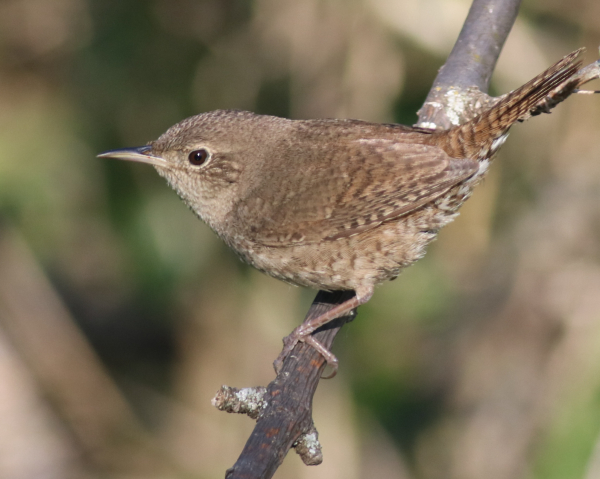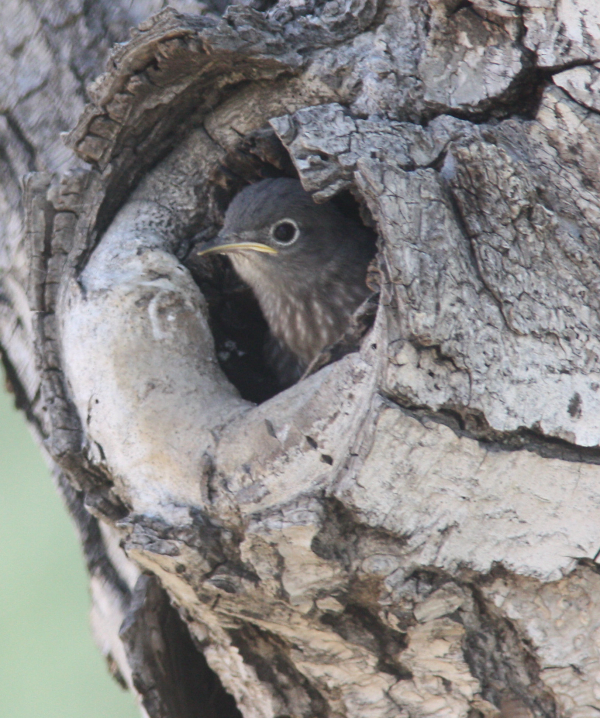
A variety of wrens will be looking for cavities and nest boxes soon, along with chickadees, titmice, bluebirds, and other native species (House Wren photo by Paul Konrad).

Natural cavities are in short supply, or non-existent, in many areas; and they may be more susceptible to predators. Each bird house can make a big difference for nesting pairs (Western Bluebird nestling photo by Paul Konrad)

Eastern Bluebird populations have increased in some areas as a direct result of the efforts of local birders to provide ever-increasing numbers of safe nest boxes in appropriate habitat.
|
It won’t be long before cavity nesting songbirds begin searching for nest sites – natural tree cavities or old woodpecker-excavated nesting cavities. Bluebirds, wrens, chickadees, titmice, and some swallows are among the 88 species of cavity nesting birds in North America. But there’s a problem: There is a lack of adequate natural cavities, including woodpecker-excavated nesting cavities, which creates a lot of competition, and may even mean that some pairs won’t nest. That’s where we birders come into the scene, adding nest boxes (bird houses) to our yards.
If you already have a bird house or 2 in your yard, you are already a birdhouse “landlord,” and appreciate all the fun and joy that wrens and bluebirds can bring to your yard, workplace, or extended property. If that’s the case, it’s time to give your nest boxes a “spring check” to make sure each one is ready for new occupants and the potential of a new avian family.
New Additions
It’s also a good time to consider adding a new nest box to your landscaping; it can only be a helpful addition for cavity nesting birds. Adding nest boxes to local areas across the continent interested and concerned birders have been instrumental to increasing local populations of bluebirds in particular, although other species have benefitted similarly to the cumulative effects of birders’ providing suitable, safe housing.
Every bird house is important, but some people take their nest box activities to more inspired levels, creating “bluebird trails” that may number somewhere between a few to many nest boxes positioned along a “trail” that the “landlord” can walk or drive to, perhaps along a fence line across a grassy field, along the edge of a wooded area, or through a number of habitats. This is especially true for bluebird promoters, who do all they can to help ensure their favorite birds have adequate safe nest sites.
Size Conscious
Whether you have one or more nest boxes, it’s important to understand there is more to it than simply installing a nest box. Providing a nest box with the appropriate dimensions, a swinging door, and an appropriate-sized entrance hole for the birds you wish to attract is the first important step. Luckily, there is a super resource for anyone to access that provides all the information you should consider to be a successful landlord.
NestWatch, a part of the Cornell Lab of Ornithology, provides the essential information about any nest box for any North American cavity nesting species. This infor includes the size of the nest box, the all-important size of the entrance hole, preferred habitats of different species, the nesting elevation preferred by species, and more to help make your bird house landlord efforts most successful. All this and more is available at https://nestwatch.org/learn/all-about-birdhouses/
Predator Proofing
To truly benefit cavity nesting birds, we need to make sure that each bird house is predator-proof. By predators, we mostly mean small mammals including squirrels, chipmunks, cats, and raccoons; plus snakes, which are mostly a concern for birders in southeastern states, but you get the idea – make it predator-proof. As birdhouse landlords, we must make sure the afore-mentioned animals and others like them cannot reach the nest box entrance. This is best accomplished by installing raccoon-proof predator guard or baffle, which should keep any potential predators from accessing a nest box.
How important is predator proofing? If predators can get to the eggs, nestlings, or adult birds, you aren’t providing a nesting site, you are providing a feeding site for predators: That’s a cold hard fact. So for more information about predator proofing options, refer directly to the NestWatch “dealing with predators” page at https://nestwatch.org/learn/all-about-birdhouses/dealing-with-predators/
With this information in mind, consider your current bird houses, and be encouraged to move existing birdhouses on your property to a safer location if needed – perhaps secured on a post with a predator guard attached to ensure the safety of future residents, year after year. When you check habitat and elevation preferences of species you wish to attract, you may find you need to reposition a nest box to attract a pair of the species you hope to attract.
Perhaps you’re already dialed in and your existing nest boxes are in all the right places with all the right predator options. Then, it may be picking out your next addition to benefit cavity nesting birds I your area. In this issue, we feature a list of interesting nest boxes in our Products section that may interest you, or even inspire you. When you really think of it bird houses are really important, but they can also offer interesting and rewarding observations, and add some more fun to your spring and summer birding activities. Being good nest box landlords helps to make us better and more successful birders. Think spring, think birds; good luck!
Share your backyard birding experiences and photos at editorstbw2@gmail.com